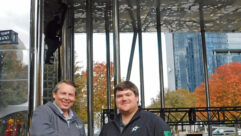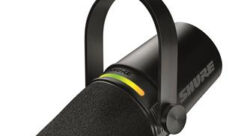
Expert Viewpoint: Reverb Matters
Jan 1, 2009 12:00 PM,
By Peter Janis
Making money with acoustics.

Ninety-five percent of acoustic problems in commercial markets such as health clubs, restaurants, and houses of worship are voice- or communication-related. To improve intelligibility, you must reduce the echo.
There are tremendous business opportunities in the field of acoustics for sound contractors. The obvious markets are music schools, gymnasiums, and houses of worship. But there are many more: cafeterias, museums, call centers, dance studios, libraries, classrooms, and industrial applications. In fact, if you actually stop and think about it, the market for acoustics is absolutely huge — but it remains largely untapped.
What few contractors realize is that the science known as “acoustics” is actually not that complex. More importantly, as an audio specialist, you have a tremendous advantage over the typical drywall contractor: You know how sound actually behaves. For instance, you know that high frequencies with their short wavelengths are more directional, and therefore, they can be controlled using simple vectors. You also know that in a PA system, it takes about 20 times more power to drive a low-frequency bass driver to get those long, low-frequency waves to move. This tells you that controlling bass will require a whole lot more effort than controlling high frequencies. So for now, forget about managing bass — it’s hard and often impossible. Focus your efforts on the easier-to-pick fruit, where sound becomes directional above 400Hz. This happens to be where the voice-communication range starts — another important piece of knowledge you should hold.
The markets can be broken out into four basic categories: industrial, commercial, institutional, and music-related.
INDUSTRIAL MARKETS
This category includes bottling plants, printing presses, metal fabricators, wood shops, and other noisy industrial environments. The key motivator in this market is industrial safety. The Occupational Safety and Health Administration (OSHA) established a standard that requires industry facilities to implement a noise-monitoring program when exposure to noise exceeds an 8-hour average of 85dBA.
Safety also comes in the form of communication. If someone yells, ‘Be careful — a grand piano is about to drop on your head,’ and you do not hear the call, someone can get hurt. Treatment in such environments is usually in the form of acoustic panels spread around the perimeter to control the reverberant field and increasing the density of the acoustic panels around offending equipment. The easy way to identify an industrial customer is to get yourself a noise-decibel-level meter and offer the local industrial community a free sound-measurement test. Make up a simple chart with, say, 12 readings, and have a second page with grid paper to sketch the floor plan. Walk around the plant with your meter and write down your decibel readings in the various areas. If the noise level is above 85dB, you are potentially in the money.
COMMERCIAL MARKETS
This category includes boardrooms, call centers, cafeterias, lobbies, restaurants, health clubs, community centers, houses of worship, airports, and arenas. Ninety-five percent of the acoustic problems in these markets are voice- or communication-related. Increasing the size of the PA system will generally cause more harm than good in such situations. Simply stated, the problem has to do with too much echo in the room, which makes it impossible for the brain to discern the information being broadcast.
To improve intelligibility, you have to reduce the echo. Once again, treatment is a matter of strategically placing acoustic panels on the walls or hanging them from the ceiling to reduce the RT60, or reverberant time of the room. The more acoustic panels you put up, the less reverb you will have. For voice, an RT60 of less than 1 second is preferred. A simple clicker (or hand clap) with a stopwatch is all you need to evaluate the problem. If the echo lasts beyond a couple of seconds, you have a new customer.
Expert Viewpoint: Reverb Matters
Jan 1, 2009 12:00 PM,
By Peter Janis
Making money with acoustics.

In institutional markets such as dance studios, school classrooms, and libraries, treatment is usually in the form of wall-mounted acoustic panels and high-performance ceiling tiles to improve intelligibility and help kids learn better.
INSTITUTIONAL MARKETS
This category includes school classrooms, school cafeterias, music schools, dance studios, fitness centers, gymnasiums, libraries, and other public places. The good news is that the government is encouraging schools to improve acoustics in classrooms through programs such as the Collaborative for High Performance Schools (CHIPS) program, which encourages low-cost loans to improve classroom comfort. Acoustic comfort means teachers and students can hear one another. By improving intelligibility, kids are better able to learn. Treatment is usually in the form of wall-mounted acoustic panels and high-performance ceiling tiles that combine absorption with mass to contain or keep out sound.
Most important is that panels used in these installations must be both safe — ASTM E-84-tested for fire, smoke, and legal liability — and durable. Most acoustic foam panels (urethane) cannot be used, as they will not conform to the building code. Melamine foam panels are generally safe, but they are easily damaged. Fabric-covered high-density fiberglass panels tend to be the preferred choice as they have a tough outer cover and are significantly more effective at controlling sound in the lower voice-range frequencies.
A simple mailer to your local schools, union offices, and municipal centers offering a free acoustic evaluation test will often generate sales leads. Walk in with a test meter, your clicker, and a stopwatch, and you can assess the situation in minutes. If the reverberant echo lasts longer than 2 seconds, you can help by treating the walls with acoustic panels. Most importantly, you need to ask questions to quantify the situation. You may find that the restaurant owner has had complaints about clients not being able to converse due to the noise. For fun, walk into your local library and speak at a regular level. If your voice carries, you have yet another customer. Go into the school cafeteria and clap your hands. If it echoes forever, bingo: another customer.
MUSIC-RELATED MARKETS
Music-related customers include school music programs, teaching studios, practice rooms, performance venues and theaters, recording and postproduction studios, broadcast stations, movie sound stages, night clubs, and pretty much all of your customers that have bought a PA system. These customers can be a great source of opportunity, but be careful — controlling bass is really tough. So trying to stop bass from the disco upstairs from entering the funeral parlor below may be futile. Sound travels through everything. If it vibrates, sound will pass. If it is connected, sound will travel through it like a conduit. This is where you need to use some good practical common sense before you get involved.
To control sound such as the reverberant time decay in a room, one generally mounts a bunch of acoustic panels to the walls. To contain sound or stop it from going in or out of a room requires more thought. Think of a loudspeaker backwards — woofers need to vibrate freely in order to generate sound waves. For your walls to stop sound, they too must vibrate while acting like barriers. Tricks that are often used in acoustics to contain sound include building a wall in front of another wall. In studio construction, this is called an offset stud wall. For pre-existing construction, using U-shaped resilient channel lets you float a layer of gypsum board in front of the existing wall to create air space between them. This allows the first wall to vibrate freely without connecting to the second wall. You can go a step further by hanging a loaded vinyl barrier inside the wall to increase the mass.
In music applications, it is usually a matter of combining both absorption and containment. Absorption is used to reduce the sound inside the room, while containment stops sound from both entering and exiting the room.
A simple letter to your customers letting them know that you can provide solutions to control sound will likely generate immediate sales leads. Your previous customers know you and they know your work. For music educators, again, you have a huge advantage: You know music, you know sound, and you can converse with them on a level that they will be comfortable with. Most music teachers are not sound-savvy, they are music-savvy. They view you as an authority, and therefore, they can explain their concerns in terms that you will understand.
JUST LIKE A BACKWARDS LOUDSPEAKER
In many ways, acoustic sound control is the mirror image of a sound system. Consider a three-way PA system — where the tweeter generates the high-frequency details, the mids generate the all-important voice range, and the woofer generates the booming bass. In acoustics, it is the same, only backwards.
In acoustics, the thicker the panel, the lower the frequency it will absorb. For room chatter such as that in call centers and offices, 1in.-thick, high-density, 6lb. fiberglass panels will usually do the trick by attenuating high frequencies above 1kHz. For the voice range, thicker 2in. or 3in. panels will extend the low-frequency absorption down to 500Hz. Bass management requires the use of springs, decoupling techniques, and plenty of mass. By focusing your attention on the lower fruit (mid- and high-frequency problems), you can eliminate many of the problems common to most rooms.
Best of all, you cannot go too far wrong. The more panels you put up, the darker or less ambient the room will sound. This means that the solution will usually be a matter of budget versus desired outcome. As soon as you treat 15 percent of the room’s wall surface area, you will begin to hear a notable improvement. You may just be surprised at how quickly the client may open the purse strings once the staff and customers notice the improvements.
Next time, we will discuss fire-safety issues and tricks to panel placement for best results.










